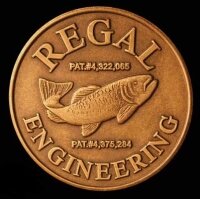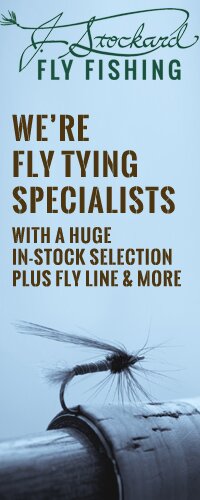Rich Strolis is a commercial fly tyer specializing in custom flies for the rivers of the northeastern U.S. and abroad. He was most notably known for his 10 years as an independent guide on the Farmington River, and has been fishing for over 30 years, with 25 years of tying experience. Rich believes that a great deal of his experience and success is a direct bi-product from his time spent on the water on various rivers and streams across the lower 48 and Alaska.
Prior to kids and family he spent 200 plus days a year on the water before and after work, yes that is correct, he has a full time career on top of all this too,(can you say a Type A to the core? No doubt, and a character to boot). Rich is a subsurface fanatic who loves to chase trophy trout with larger streamers and nymphs of all sizes and if you check out his website you will see this clearly. Rich recently gave guiding a backseat to spend more time with his two little girls Tessa and Nora, and very understanding and supportive wife Megan. Very open and approachable, Rich loves sharing his efforts with anyone, and he enjoys tying flies almost as much as fishing them.
Some of his creations have appeared in the pages of Flyfisherman magazine, Eastern Fly Fishing magazine, Flyfishing and Tying Journal, Orvis Flyfishing Blog, Global Flyfisher, Hatches Online, and books by noted aquatic insect photographer, Thomas Ames. Rich currently runs a website devoted to his fly business and passion for fly-tying where he does frequent fly-tying tutorials that demonstrate step by step construction of some of his own flies and other time tested patterns. Below you will find some of his best creations. For more about Rich, visit his website at www.catching-shadows.com.

Articulated Ice Pick
Rear section
Hook: Gamakatsu B10s. size 2 or 4.
Thread: UTC 140 color to match
Foul Guard: 50 pound mono loop
Tail: Marabou
Wing: Bar Dyed Rabbit Strip
Body: EP Sparkle brush
Collar: Senyo Laser Dub color to match (light dressing)
Front section
Hook: Gamakatsu B10s. Size 1 or 2. (1size larger than rear)
Thread: UTC color to match
Connection: 19 strand beadalon and 2 3D proeyes or glass beads size E(large)
Rear Collar: marabou or schlappen fluff palmered.
Wing: Bar Dyed Rabbit Strip
Body: EP Sparkle brush
Collar: Senyo Laser Dub color to match (heavy Dressing)
Throat (optional): red Senyo Laser Dub
Head: Fish Skull color to match. Size 1 sm/med. size 2 small

Shimmer Stone
Hook: TMC 2302
Thread: UTC 140
Underbody: Uni Stretch over Lead Free Wire
Tails/Antenae: Life Flex or spanflex
Back/wingcase: Flashback
Overbody: Medium D Rib Light Golden stone
Legs: Brahma hen
Gills/dub: Haretron
Head: Non tungsten bead

Hog Snare Streamer
Rear Section
Hook: Gamakatsu SP11-3L3H size 2
Thread: UTC 140 color to match
Tail: Holographic Flashabou under schlappen fluff under Marabou
Body: medium cactus chenile
Hackle: Schlappen Palmered
Mottling: Bar Dyed crazy legs
Wing: Reverse tied arctic fox tail.
Middle Section
Medium Fish Skull Articulated shank wrapped with .020 Lead Free wire
Thread: UTC 140 color to match
Rear Collar: Holographic Flashabou under schlappen fluff
Body: medium cactus chenile
Hackle: Schlappen Palmered
Mottling: Bar Dyed crazy legs
Wing: Reverse tied arctic fox tail.
Connection: 19 Strand Beadalon Stringing wire (.018 dia) with 2 Janns Netcraft 3d pro eye beads
Front Section
Hook: Gamakatsu B10s size 1
Thread: UTC 140 color to match
Rear Collar: Holographic Flashabou under schlappen fluff
Body: medium cactus chenile
Hackle: Schlappen Palmered
Mottling: Bar Dyed crazy legs
Wing: Reverse tied arctic fox tail.
Collar: Senyo Laser Dub
Head: Senyo Laser Dub Spun and brushed out
Eyes: Chartreuse Lead Dumbell Eyes Or Pseudo Eyes

Headbanger Sculpin
Rear Section
Hook: Gamakatsu SP11-3L3H size 2
Thread: UTC 140 color to match
Tail: Holographic Flashabou under two palmered marabou plumes
Body: medium cactus chenile
Hackle: Schlappen Palmered
Mottling: Bar Dyed crazy legs
Wing: Reverse tied arctic fox tail (inverted)
Connection: 19 Strand Beadalon Stringing wire (.018 dia) with 2 Janns Netcraft 3d pro eye beads
Front Section
Hook: Gamakatsu B10s size 1
Thread: UTC 140 color to match
Rear Collar: Holographic Flashabou under two palmered marabou plumes
Body: medium cactus chenile
Hackle: Schlappen Palmered
Mottling: Bar Dyed crazy legs
Wing: Reverse tied arctic fox tail. (inverted)
Collar: Senyo Laser Dub
Head: Fish Skull large sculpin Helmet

 I purchase a lot of Hareline Dubbin supplies and I am always happy with the quality. So tonight I researched a little about Bob Borden, the owner of Hareline Dubbin to see what I could dig up.
I purchase a lot of Hareline Dubbin supplies and I am always happy with the quality. So tonight I researched a little about Bob Borden, the owner of Hareline Dubbin to see what I could dig up.







 The Great Lakes Council of the Federation of Fly Fishers are hosting their 13th Annual Fly Tying Exposition at Holt High School in Holt, Michigan on Saturday, December 1, 2012. I would love to make it up there for this, but I’m not sure if it is something I can realistically do. But there are going to be some great tyers there for sure!
The Great Lakes Council of the Federation of Fly Fishers are hosting their 13th Annual Fly Tying Exposition at Holt High School in Holt, Michigan on Saturday, December 1, 2012. I would love to make it up there for this, but I’m not sure if it is something I can realistically do. But there are going to be some great tyers there for sure! I don’t ever tie Mary Orvis Marbury style flies, but they are beautiful fly patterns. Probably my favorite M.O.M. fly is the Cracker. Mary describes the fly as “A fly with a record, and evolved by most careful study and experiment. It is intended for the coast and river fishes of Florida, and is named after the natives of that State, the “pore whites”. The pattern was created by Dr. George Trowbridge way back in the year 1888.
I don’t ever tie Mary Orvis Marbury style flies, but they are beautiful fly patterns. Probably my favorite M.O.M. fly is the Cracker. Mary describes the fly as “A fly with a record, and evolved by most careful study and experiment. It is intended for the coast and river fishes of Florida, and is named after the natives of that State, the “pore whites”. The pattern was created by Dr. George Trowbridge way back in the year 1888. Pat Barnes was a fly fishing legend that owned a fly shop in West Yellowstone, Montana. Being a history buff, I’ve studied quite a bit of the life of Mr. Barnes and have luckily been able to talk to his son, Charles, via e-mail. One of the items Charles sent me was a paper bag that Pat had written fly tying tips on. I’ve posted one image of it here. I’ve read through it and deciphered as much as I can. There were a few words that I couldn’t quite read, but I was able to type out most of it. I thought it would be interesting to post it here. So below you can read some tying tidbits from one of the best.
Pat Barnes was a fly fishing legend that owned a fly shop in West Yellowstone, Montana. Being a history buff, I’ve studied quite a bit of the life of Mr. Barnes and have luckily been able to talk to his son, Charles, via e-mail. One of the items Charles sent me was a paper bag that Pat had written fly tying tips on. I’ve posted one image of it here. I’ve read through it and deciphered as much as I can. There were a few words that I couldn’t quite read, but I was able to type out most of it. I thought it would be interesting to post it here. So below you can read some tying tidbits from one of the best. The Bloody Muddler is a steelhead fly originated by Leroy Hyatt. Mr. Hyatt is known for his fly tying on the PBS show Fly Tying: The Angler’s Art. It was an excellent show and you can watch many of the episodes online. Also check out YouTube for Leroy Hyatt videos.
The Bloody Muddler is a steelhead fly originated by Leroy Hyatt. Mr. Hyatt is known for his fly tying on the PBS show Fly Tying: The Angler’s Art. It was an excellent show and you can watch many of the episodes online. Also check out YouTube for Leroy Hyatt videos.













